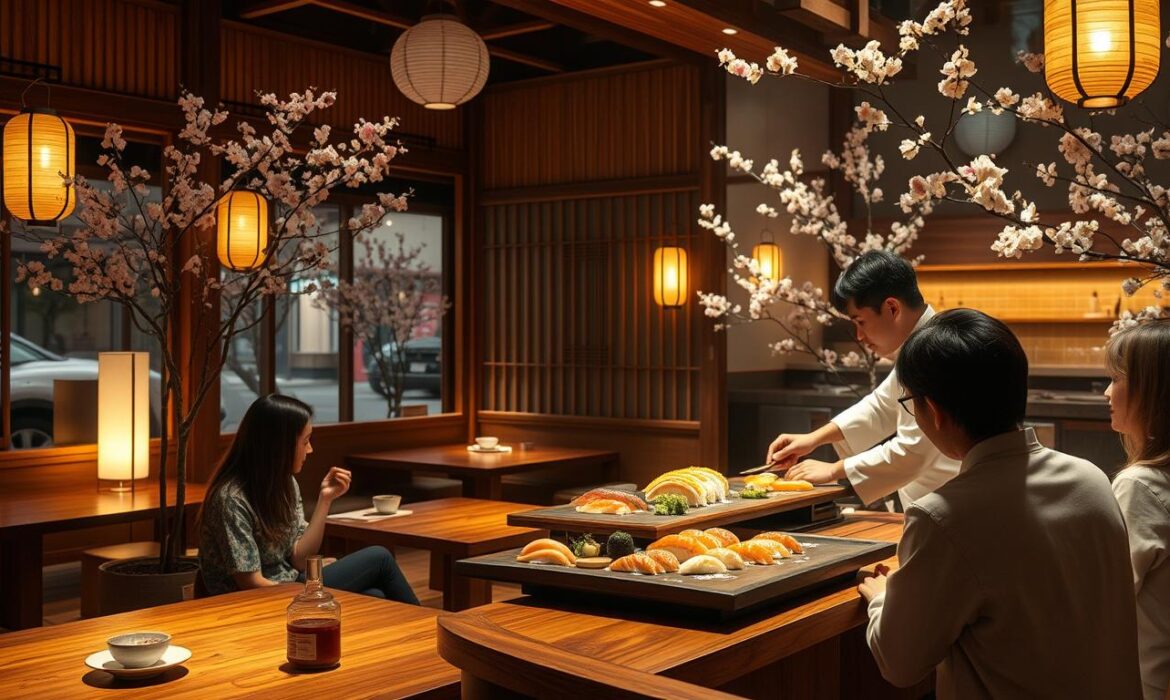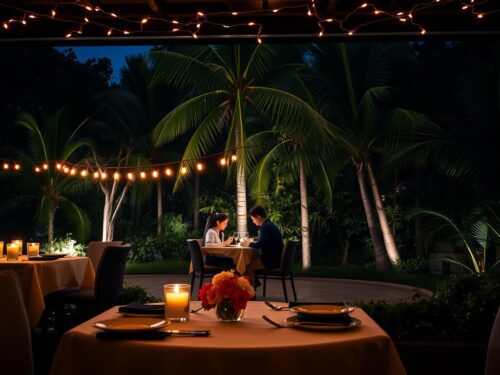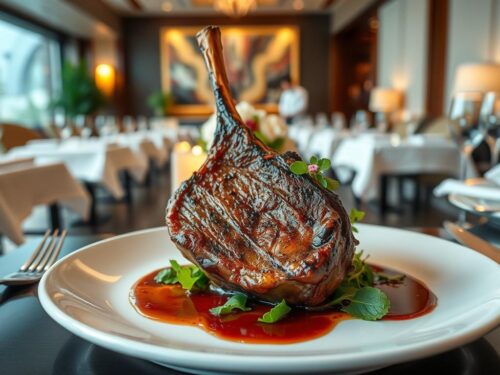Singapore’s culinary landscape is a treasure trove of unique flavors, especially when it comes to Japanese cuisine. While big names often steal the spotlight, there’s a growing number of under-the-radar spots that deserve attention. These hidden gems offer a dining experience that’s both intimate and unforgettable.
From expertly crafted sushi to innovative menus, these venues are defined by their attention to detail. Chefs here take pride in sourcing the freshest ingredients, often directly from Japan’s Toyosu Market. Whether it’s a vegetarian-focused concept or a wagyu-centric menu, each place brings something special to the table.
What sets these spots apart is their commitment to quality and creativity. They may not have the same fame as some mainstream establishments, but their offerings are just as impressive. If you’re looking to explore beyond the usual, this guide will introduce you to some of the most exciting options available.
Key Takeaways
- Singapore’s dining scene includes many underrated Japanese restaurants.
- Chefs focus on fresh, high-quality ingredients for their menus.
- Unique concepts like vegetarian and wagyu-centric options are available.
- These spots offer a more intimate and personalized dining experience.
- Seasonal sourcing from Japan ensures authenticity and flavor.
Introduction to Omakase Dining in Singapore
Omakase dining is more than a meal; it’s a cultural journey that blends tradition with innovation. Originating in post-WWII Tokyo, this culinary practice has evolved into a global phenomenon. In Singapore, it has taken on a unique identity, combining Japanese authenticity with local influences.
At its core, omakase is about culinary surrender. Diners entrust the chef to craft a personalized experience, often featuring seasonal ingredients sourced directly from Japan. This trust transforms dining into an art form, where every dish tells a story.
Singapore’s location as a hub for fresh seafood imports adds to the allure. Daily flights ensure that ingredients like tuna and uni arrive at their peak freshness. Local chefs also incorporate tropical fruits and Peranakan flavors, creating a fusion that’s both unexpected and delightful.
The pandemic has reshaped the omakase experience. Contactless menus and spaced counter seating have become the norm, ensuring safety without compromising the intimacy of the meal. Despite these changes, the essence of omakase remains intact.
Today, omakase menus extend beyond sushi. Tempura, wagyu, and even vegetarian options are gaining popularity. A typical progression includes zensai (appetizers), sashimi, nigiri, and dessert, offering a well-rounded dining experience.
Surprisingly, 40% of diners in Singapore have tried omakase at least once. This growing interest reflects a deeper appreciation for Japanese cuisine and the artistry behind it. Whether you’re a seasoned foodie or a curious newcomer, omakase promises an unforgettable journey.
What Makes Omakase a Unique Dining Experience?
The essence of omakase lies in its ability to surprise and delight with every course. Unlike traditional meals, where you choose from a menu, omakase puts the chef in control. This trust transforms dining into an intimate and artistic experience.
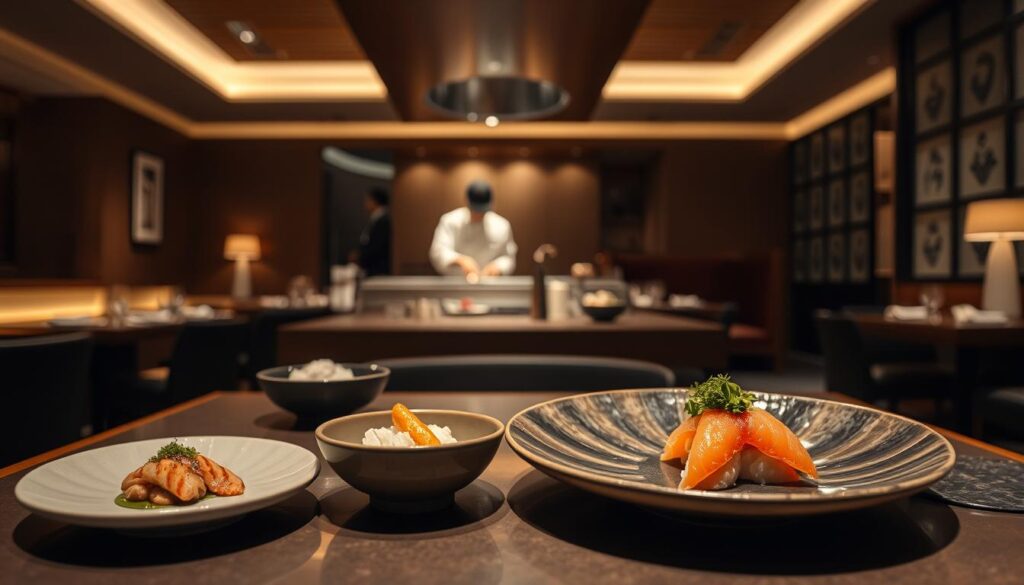
The Art of Trusting the Chef
At the heart of omakase is the shokunin philosophy. This Japanese concept views the chef as a culinary artist rather than just service staff. Chefs spend over a decade honing their craft before leading their own counters. Their expertise ensures every dish is a masterpiece.
Diners often share their preferences and allergies, allowing the chef to tailor the meal. This interaction creates a personalized dining experience. From hand-carved otoro to perfectly aged fish, every detail reflects the chef’s dedication.
Seasonal Ingredients and Personal Attention
Omakase thrives on the use of fresh, seasonal ingredients. Chefs often source directly from Japan’s Tsukiji Market or Kyoto vegetable farms. This ensures the highest quality and authenticity in every bite.
Menus rotate with the seasons, offering spring sakura or winter crab dishes. This keeps the experience fresh and exciting. The pacing of omakase, typically 1.5 to 3 hours, allows diners to savor each course fully.
| Aspect | Omakase | Western Tasting Menus |
|---|---|---|
| Pacing | 1.5-3 hours | 1-2 hours |
| Chef Interaction | High | Low |
| Ingredient Focus | Seasonal, fresh | Varied, often less seasonal |
This focus on quality and personal attention makes omakase a truly unique dining experience. Whether you’re a first-timer or a seasoned foodie, it’s a journey worth taking.
Top Omakase Restaurants in Singapore 2021
Exploring the world of omakase reveals a blend of artistry and tradition. From Michelin-starred establishments to affordable newcomers, the dining scene offers something for everyone. Here’s a curated list of standout venues that showcase the variety and creativity of this culinary practice.
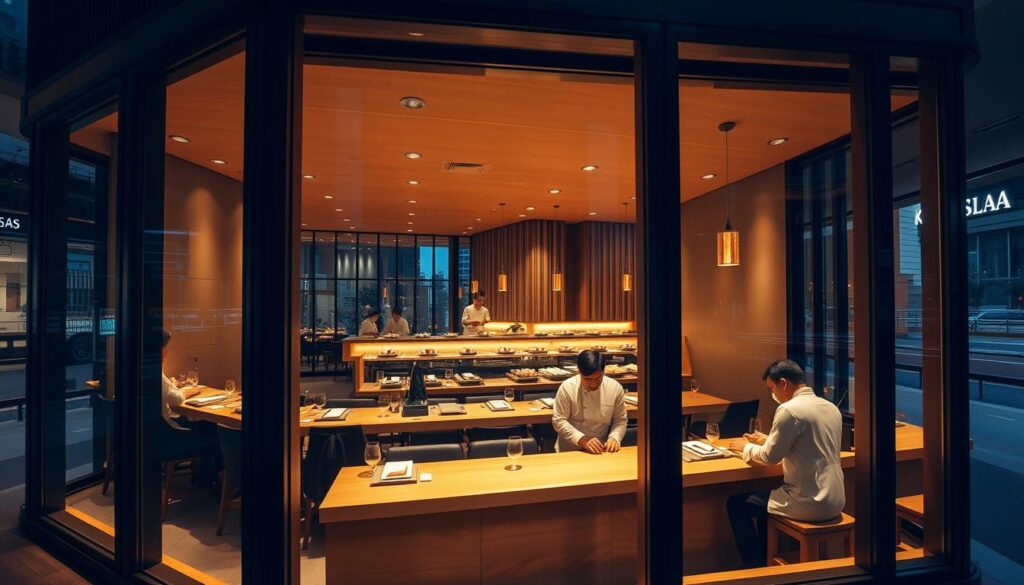
Suzuki, designed by Kengo Kuma, is a masterpiece in itself. With its minimalist aesthetic and Tokyo-trained chefs, it’s a must-visit for those seeking authenticity. Ki Su Shoujin stands out with its vegetarian kaiseki, offering a unique twist on traditional Japanese restaurant fare.
Sakemaru Artisan Sake Hideout is a haven for sake lovers. Pairing artisanal sake with seasonal dishes, it’s a sensory delight. Kakushin and Shunsui, located in Tanjong Pagar, are known for their intimate settings and meticulously crafted menus.
For those who prefer wagyu, The Gyu Bar offers a beef-centric omakase experience. Mizuki combines tempura and sushi, providing a dual dining adventure. Sushi Hare, with its serene ambiance, is perfect for a quiet evening.
COVID-safe features like UV sanitization and private dining options ensure a comfortable experience. Prices range from $39++ for lunch deals to $650++ for premium menus, catering to all budgets.
| Restaurant | Specialty | Price Range |
|---|---|---|
| Suzuki | Authentic Tokyo-style | $250++ |
| Ki Su Shoujin | Vegetarian Kaiseki | $120++ |
| Sakemaru | Sake Pairings | $180++ |
| The Gyu Bar | Wagyu Omakase | $300++ |
Whether you’re a seasoned foodie or a curious newcomer, these omakase restaurants promise an unforgettable journey through flavors and craftsmanship.
Suzuki: A Masterpiece by Kengo Kuma
Suzuki, designed by the renowned architect Kengo Kuma, is a culinary and architectural marvel that redefines the dining experience. The japanese restaurant features a 600kg ancient stone entrance and a stunning bamboo ceiling installation, creating an ambiance that blends tradition with modernity.
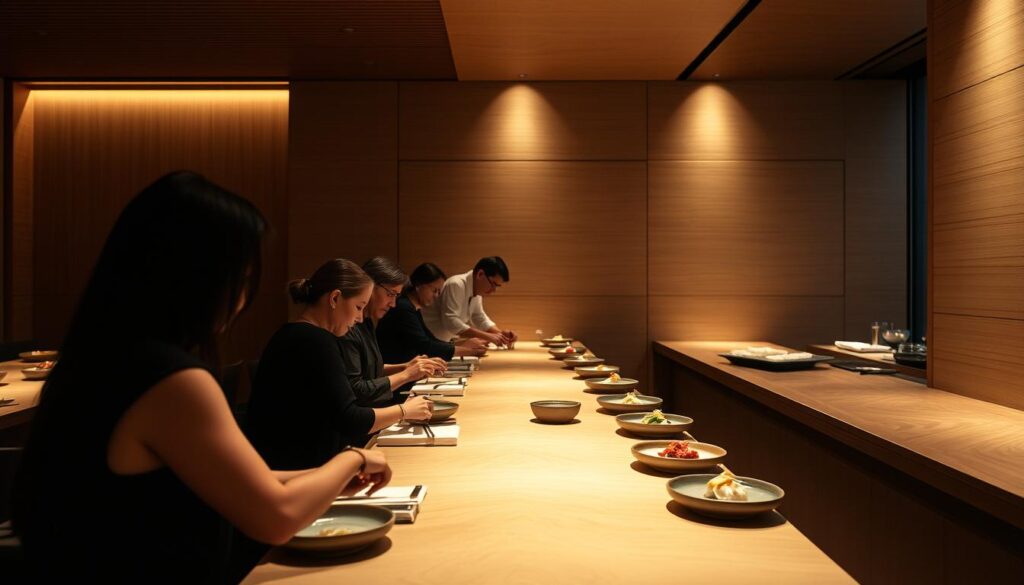
At the heart of Suzuki is chef Suzuki Yuichiro, whose 20 years of sushi mastery bring authenticity and artistry to every dish. The menu offers three lunch and dinner sets, ranging from S$160 to S$450++, with premium bluefin tuna as a standout option.
Pros and Cons of Dining at Suzuki
Dining at Suzuki comes with its unique advantages and considerations:
- Pros:
– Exceptional attention to detail in both food and design.
– Seasonal ingredients sourced directly from Japan.
– Signature dish: Otoro hand-cut from a whole tuna display. - Cons:
– Limited seating due to COVID protocols (reduced from 12 to 8 counter seats).
– High demand requires booking 6 weeks ahead for weekend dinners.
Location and Opening Hours
Suzuki is conveniently located near major MRT stations, with parking alternatives available for those driving. The opening hours are tailored to accommodate both lunch and dinner courses, ensuring flexibility for diners.
Special events, such as seasonal kaiseki collaborations with Kyoto chefs, add an extra layer of exclusivity. Whether you’re a first-time visitor or a regular, Suzuki promises an unforgettable omakase experience.
Ki Su Shoujin: Vegetarian Omakase Excellence
Ki Su Shoujin redefines vegetarian dining with a focus on natural flavors and artistic presentation. This japanese restaurant elevates plants without relying on mock meats, offering a dining experience that’s both innovative and authentic. Every meal is a celebration of fresh, seasonal ingredients sourced from organic farms in Cameron Highlands.
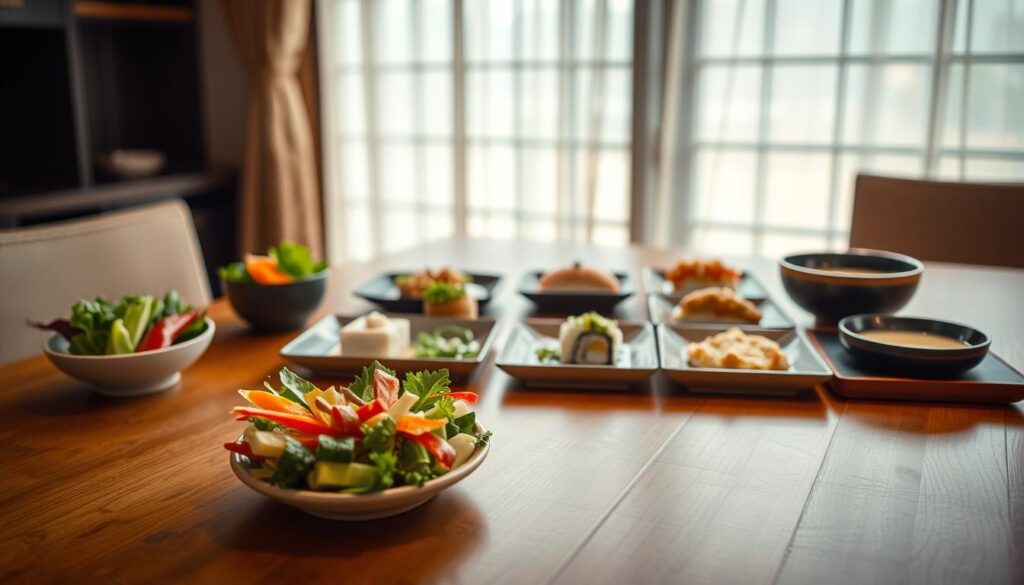
What to Expect at Ki Su Shoujin
The menu at Ki Su Shoujin is a testament to creativity. Signature dishes like lotus root “sashimi” and mushroom chawanmushi showcase the chef’s ability to transform simple ingredients into culinary masterpieces. The vegetarian approach ensures that every bite is both healthy and flavorful.
Seasonal rotations keep the menu dynamic. Monsoon mushroom courses and summer fruit dishes highlight the freshest produce available. Beverage pairings include artisanal teas and premium sakes, adding another layer to the dining experience.
Pricing and Menu Highlights
Ki Su Shoujin offers an affordable alternative to seafood omakase, with prices starting at $120++. This makes it accessible for those looking to explore a unique meal without breaking the bank. The restaurant’s location near Tanjong Pagar MRT adds to its convenience.
However, diners with nut allergies should note that the menu is nut-heavy. Despite this, the focus on fresh, seasonal ingredients ensures that every visit is a memorable one.
Sakemaru Artisan Sake Hideout: A Sake Lover’s Paradise
Sakemaru Artisan Sake Hideout offers a unique blend of tradition and innovation for sake enthusiasts. This hidden gem is a celebration of Japanese craftsmanship, where every detail is designed to enhance your dining experience. From rare aged sakes to expertly paired dishes, Sakemaru is a haven for those who appreciate the finer details of Japanese cuisine.
Unique Features of Sakemaru
At Sakemaru, the chef takes center stage with theatrical presentations that reveal hidden dishes. The sake sommelier service offers rare aged varieties, ensuring every sip is a journey through Japan’s rich brewing traditions. The menu features a variety of cooking techniques, with eight different styles showcased in each omakase course.
During the pandemic, Sakemaru introduced sake tasting kits for takeaway, allowing guests to enjoy the experience at home. Seasonal specials, like winter crab roe sake infusions, add a unique touch to the menu.
Must-Try Dishes and Sake Pairings
One of the highlights at Sakemaru is the signature pairing of Hokkaido uni with Daiginjo sake. This combination brings out the rich, creamy flavors of the seafood while complementing the sake’s delicate notes. Other must-try dishes include tempura and sashimi, each expertly paired with a sake that enhances its flavors.
For those planning a visit, Sakemaru is conveniently located near bus stops, though ride-hail services are recommended for ease of access. The dining experience typically lasts three hours, allowing ample time to savor each course and pairing.
Takahashi Singapore: Zen Dining Experience
Step into Takahashi Singapore, where Zen-inspired design meets exquisite omakase. This japanese restaurant is housed in a Mohamed Sultan shophouse, blending wabi-sabi aesthetics with modern touches. The Zen garden with a skylight creates a tranquil atmosphere, perfect for a dining experience that feels both intimate and serene.
Interior Design and Ambiance
The design at Takahashi Singapore is a masterpiece of minimalism. Natural daylight floods the space during lunch, while moonlit dinners create a cozy, romantic vibe. The use of handmade Bizen-yaki pottery adds an authentic touch to every meal. The Zen garden, with its carefully curated elements, enhances the sense of calm and focus.
Chef’s Special Omakase Courses
At the heart of Takahashi Singapore is chef Rinto, whose expertise shines in every dish. His signature 21-day aged akami zuke is a must-try, showcasing his mastery of traditional techniques. The menu also features limited-edition recreations from Tokyo’s Ginza district, offering a taste of Japan’s culinary capital.
For those with dietary preferences, Takahashi Singapore accommodates vegan requests with 48 hours’ notice. Loyalty perks, such as anniversary gold-leaf sashimi upgrades, add a special touch for returning guests. Parking is convenient, with nearby malls offering validation.
| Feature | Details |
|---|---|
| Design | Zen garden, wabi-sabi aesthetics, handmade pottery |
| Signature Dish | 21-day aged akami zuke |
| Special Offers | Anniversary gold-leaf sashimi upgrades |
| Dietary Options | Vegan (48-hour notice required) |
Whether you’re seeking a peaceful retreat or a culinary adventure, Takahashi Singapore delivers an unforgettable omakase experience. Each visit is a journey through flavors, craftsmanship, and Zen-inspired beauty.
Mizuki: Tempura and Sushi Omakase
Mizuki offers a unique blend of tempura and sushi, creating a dual culinary experience. This restaurant is a haven for those who appreciate the artistry of Japanese cuisine. Whether you’re a fan of crispy tempura or delicate sushi, Mizuki’s menu has something to satisfy every palate.
At Mizuki, the tempura is a standout. Chefs use a 160°C sesame oil frying technique to achieve the perfect crispiness. This method ensures that each bite is light and flavorful. The sushi counter shines with specialties like Shimane silver hairtail, showcasing the chef’s expertise.
Dual Menu Options at Mizuki
One of Mizuki’s highlights is its combo strategy. The 12-piece tasting mix offers the best value, allowing diners to enjoy both tempura and sushi in one meal. For those curious about the process, chefs often demonstrate the tempura batter technique upon request.
Dietary flexibility is another plus. Mizuki offers a gluten-free tempura batter option, ensuring everyone can enjoy the dishes. Seasonal specials, like the autumn matsutake tempura course, add a unique touch to the menu.
Location and Accessibility
Located in Ngee Ann City, Mizuki is easily accessible via Orchard Road. The back entrance through Lido makes navigation simple. After your dining experience, don’t forget to collect your Takashimaya voucher with your receipt for added perks.
Mizuki’s commitment to quality ingredients and innovative techniques makes it a must-visit for anyone exploring Japanese cuisine. Whether you’re a tempura enthusiast or a sushi lover, this restaurant promises an unforgettable experience.
The Gyu Bar: Wagyu-Centric Omakase
The Gyu Bar takes wagyu to new heights with a focus on premium cuts and innovative techniques. This dining experience is a celebration of Japanese beef, showcasing the finest ingredients from seven prefectures. Each course is designed to highlight the unique flavors and textures of wagyu, making it a must-visit for meat enthusiasts.
Exploring 7 Japanese Prefectures Through Beef
At The Gyu Bar, the menu is a journey through Japan’s most renowned beef regions. From olive-fed Kagoshima to mineral-rich Shimane, each prefecture offers distinct characteristics. The chef expertly selects cuts that undergo a 21-day dry aging process, enhancing their flavor and tenderness.
During the meal, guests are treated to a butchery demo, where the chef explains the BMS marbling scoring system. This interactive element adds depth to the dining experience, allowing diners to appreciate the craftsmanship behind each dish.
8-Course Omakase Menu Highlights
The Gyu Bar’s 8-course menu is a masterpiece of culinary artistry. Each course is thoughtfully paired with robust junmai sake, complementing the richness of the wagyu. Highlights include the A5 tartare with quail yolk and a heart-shaped wagyu platter for special occasions.
For those seeking alternatives, the menu also features a vegetarian option with mushroom “steak” dishes. The chef provides cooking tips, ensuring guests can recreate the perfect doneness at home.
| Course | Description |
|---|---|
| 1 | Olive-fed Kagoshima wagyu tartare with quail yolk |
| 2 | Mineral-rich Shimane wagyu sashimi |
| 3 | 21-day dry-aged Miyazaki wagyu steak |
| 4 | Heart-shaped wagyu platter (anniversary special) |
| 5 | Mushroom “steak” (vegetarian option) |
| 6 | Wagyu tempura with seasonal vegetables |
| 7 | Wagyu sushi roll with truffle oil |
| 8 | Matcha panna cotta with wagyu caramel |
Whether you’re celebrating a special occasion or simply indulging in a luxurious meal, The Gyu Bar delivers an unforgettable omakase experience. With its focus on quality and creativity, it’s a destination that redefines wagyu dining.
Sushi Hare: Intimate and Serene
Sushi Hare offers a tranquil escape for those seeking a refined dining experience. With only a 10-seat counter, this restaurant ensures an intimate setting where every detail is carefully curated. The ambiance is enhanced by a cypress wood scenting system, creating a calming atmosphere that complements the dishes.
Chef Angus Chang’s Signature Creations
At the heart of Sushi Hare is chef Angus Chang, whose Tokyo training and Taiwanese influences bring a unique flair to the menu. His cross-cultural creations, like Oolong tea smoked kohada, showcase his innovative approach. Signature nigiri, such as the fluffy tamagoyaki with mirin glaze, highlights his mastery of traditional techniques.
For those in the know, the secret menu features midnight bluefin delivery days, offering a rare treat for seafood lovers. Beverage pairings include high-mountain tea selections, adding an extra layer of authenticity to the dining experience.
Seating and Reservation Details
Reservations at Sushi Hare require planning, with counter seats often booked two months in advance. The small seating capacity ensures personalized attention from the chef, making each visit memorable. COVID adjustments, like acrylic dividers with service gaps, ensure safety without compromising the intimate setting.
Whether you’re a sushi aficionado or new to omakase, Sushi Hare promises a serene and unforgettable journey through flavors and craftsmanship.
Conclusion: Your Ultimate Omakase Singapore 2021 Guide
From sky-high venues to intimate counters, the world of Japanese dining offers year-round surprises. Whether you’re drawn to wagyu-focused courses or innovative vegetarian menus, there’s something for every palate. Exploring beyond mainstream choices can lead to unforgettable dining experiences.
For budget-conscious diners, lunch deals provide excellent value, while splurge-worthy dinners are perfect for special occasions. Booking during off-peak times can secure last-minute seats, and seasonal calendars highlight the freshest ingredients throughout the year.
COVID-conscious options like private rooms and spaced counters ensure a safe yet intimate experience. Gift ideas such as voucher programs make for thoughtful presents, and keeping a chef’s notebook can help track your preferences for future visits.
Share your personal discoveries and let the journey of Japanese dining continue. Each omakase experience is a unique adventure, waiting to be explored.

